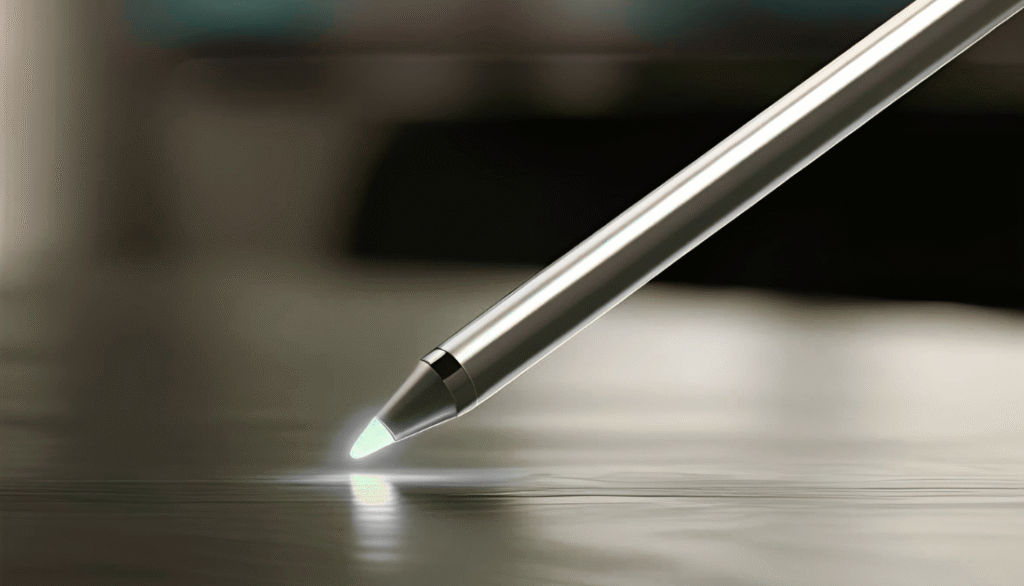A newly granted patent suggests Apple may be developing a next-generation Apple Pencil capable of functioning independently from a touchscreen.
Highlights
- Patent Unveiled: Apple has filed a patent for a stylus capable of functioning independently from any screen, using advanced tracking sensors.
- Breaks the Touchscreen Barrier: Unlike the Apple Pencil Pro, the new concept stylus could track movement on virtually any surface—or even in midair.
- Powered by Optical Flow + Laser Speckle Sensors: These technologies enable the stylus to detect motion and orientation with high precision across flat or textured surfaces.
- Airborne Input Possible: Can potentially track gestures up to 100mm above a surface—opening up midair drawing or annotation capabilities.
- Potential Applications: Could be used for AR drawing, whiteboard-style teaching, 3D sketching in Apple Vision Pro, and enhanced accessibility tools.
- Precision Comparable to Optical Mice: Offers ultra-fine tracking detail—even on curved or reflective surfaces, according to 9to5Mac and Gadgets360.
- Still a Concept: While Apple has not confirmed plans to release the product, the patent hints at long-term goals in spatial computing and creative input tools.
The filing, recently discovered by Patently Apple, outlines a stylus concept equipped with advanced optical tracking technologies—enabling users to write or draw on virtually any surface, including walls, tables, or even in midair.
A Stylus Without Touch Dependency
Currently, the Apple Pencil Pro—introduced in May 2024—represents the most advanced version of Apple’s stylus.
It includes features such as haptic feedback, a squeeze-sensitive barrel, a gyroscope, and integration with Apple’s Find My network. However, like previous models, it requires a capacitive touchscreen to function.
This new patent, filed with the United States Patent and Trademark Office (USPTO), describes a stylus that goes far beyond that limitation.
At its core is a trackball-like tip paired with optical flow and laser speckle sensors, which allow it to detect movement, orientation, and positioning across various real-world surfaces—similar to the way high-end optical mice track motion.
How It Works
The patent outlines a dual-sensor strategy,
- Optical Flow Sensors: These detect stylus movement by analyzing changes in reflected light, much like an optical mouse. The system can reportedly function at distances of up to 100 mm (about 4 inches) above a surface—meaning users could write or gesture in midair.
- Laser Speckle Flow Sensors: These sensors read interference patterns produced by coherent laser light. This enables the stylus to detect fine motion and surface textures, even on smooth or curved materials.
Combined, these technologies could allow for precise motion tracking and spatial input without requiring direct contact.
From Education to AR
In practical terms, the stylus could allow users to draw or write on virtually any surface—walls, tables, notebooks—with the resulting input captured and displayed on a paired Apple device. This would be especially useful in contexts where a screen isn’t ideal, such as:
- Teaching or presenting on whiteboards or walls
- Quick sketching on paper surfaces that syncs to digital format
- Augmented reality applications, such as drawing in 3D space
- Accessibility use cases for individuals with visual or motor impairments
The patent also aligns closely with Apple’s growing interest in augmented and spatial computing. The ability to input motion in three-dimensional space could integrate naturally with devices like Apple Vision Pro, allowing users to sketch, manipulate, or annotate within immersive environments.
Still a Concept—But with Long-Term Potential
As with many Apple patents, this technology may remain conceptual for some time. Apple has not announced any official plans to bring this stylus to market.
The company has a history of filing patents years before launching related products—making this a potential glimpse into the future of Apple’s creative tools.
Precision Meets Portability
According to 9to5Mac, the optical flow sensors described in the patent could deliver mouse-level tracking precision on a wide range of surfaces, while also functioning several centimeters above them.
Gadgets360 and India Today add that the stylus’s 3D tracking capabilities could enable novel interactions in AR environments, reinforcing its potential as an input device not just for tablets, but for Apple’s broader ecosystem of devices.


